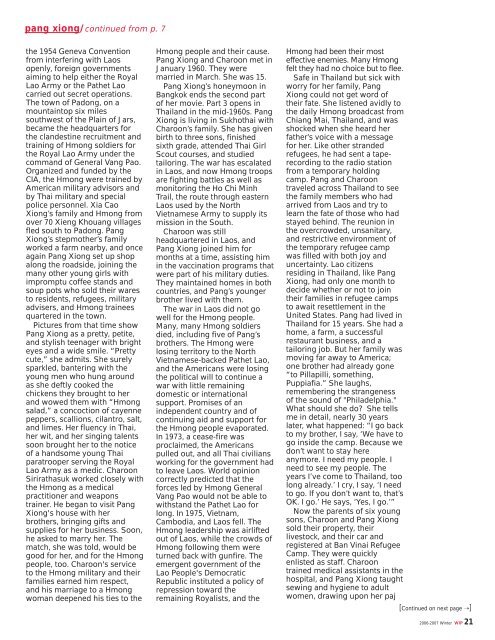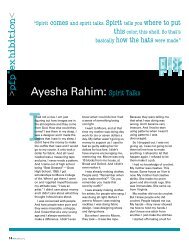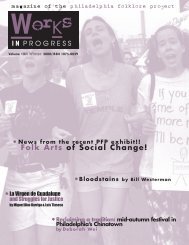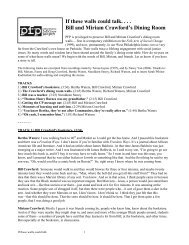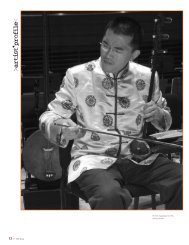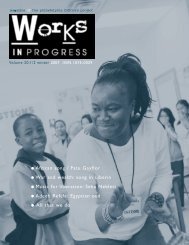View PDF - Philadelphia Folklore Project
View PDF - Philadelphia Folklore Project
View PDF - Philadelphia Folklore Project
- No tags were found...
You also want an ePaper? Increase the reach of your titles
YUMPU automatically turns print PDFs into web optimized ePapers that Google loves.
pang xiong/continued from p. 7the 1954 Geneva Conventionfrom interfering with Laosopenly, foreign governmentsaiming to help either the RoyalLao Army or the Pathet Laocarried out secret operations.The town of Padong, on amountaintop six milessouthwest of the Plain of Jars,became the headquarters forthe clandestine recruitment andtraining of Hmong soldiers forthe Royal Lao Army under thecommand of General Vang Pao.Organized and funded by theCIA, the Hmong were trained byAmerican military advisors andby Thai military and specialpolice personnel. Xia CaoXiong’s family and Hmong fromover 70 Xieng Khouang villagesfled south to Padong. PangXiong’s stepmother’s familyworked a farm nearby, and onceagain Pang Xiong set up shopalong the roadside, joining themany other young girls withimpromptu coffee stands andsoup pots who sold their waresto residents, refugees, militaryadvisers, and Hmong traineesquartered in the town.Pictures from that time showPang Xiong as a pretty, petite,and stylish teenager with brighteyes and a wide smile. “Prettycute,” she admits. She surelysparkled, bantering with theyoung men who hung aroundas she deftly cooked thechickens they brought to herand wowed them with “Hmongsalad,” a concoction of cayennepeppers, scallions, cilantro, salt,and limes. Her fluency in Thai,her wit, and her singing talentssoon brought her to the noticeof a handsome young Thaiparatrooper serving the RoyalLao Army as a medic. CharoonSirirathasuk worked closely withthe Hmong as a medicalpractitioner and weaponstrainer. He began to visit PangXiong's house with herbrothers, bringing gifts andsupplies for her business. Soon,he asked to marry her. Thematch, she was told, would begood for her, and for the Hmongpeople, too. Charoon's serviceto the Hmong military and theirfamilies earned him respect,and his marriage to a Hmongwoman deepened his ties to theHmong people and their cause.Pang Xiong and Charoon met inJanuary 1960. They weremarried in March. She was 15.Pang Xiong’s honeymoon inBangkok ends the second partof her movie. Part 3 opens inThailand in the mid-1960s. PangXiong is living in Sukhothai withCharoon’s family. She has givenbirth to three sons, finishedsixth grade, attended Thai GirlScout courses, and studiedtailoring. The war has escalatedin Laos, and now Hmong troopsare fighting battles as well asmonitoring the Ho Chi MinhTrail, the route through easternLaos used by the NorthVietnamese Army to supply itsmission in the South.Charoon was stillheadquartered in Laos, andPang Xiong joined him formonths at a time, assisting himin the vaccination programs thatwere part of his military duties.They maintained homes in bothcountries, and Pang’s youngerbrother lived with them.The war in Laos did not gowell for the Hmong people.Many, many Hmong soldiersdied, including five of Pang’sbrothers. The Hmong werelosing territory to the NorthVietnamese-backed Pathet Lao,and the Americans were losingthe political will to continue awar with little remainingdomestic or internationalsupport. Promises of anindependent country and ofcontinuing aid and support forthe Hmong people evaporated.In 1973, a cease-fire wasproclaimed, the Americanspulled out, and all Thai civiliansworking for the government hadto leave Laos. World opinioncorrectly predicted that theforces led by Hmong GeneralVang Pao would not be able towithstand the Pathet Lao forlong. In 1975, Vietnam,Cambodia, and Laos fell. TheHmong leadership was airliftedout of Laos, while the crowds ofHmong following them wereturned back with gunfire. Theemergent government of theLao People's DemocraticRepublic instituted a policy ofrepression toward theremaining Royalists, and theHmong had been their mosteffective enemies. Many Hmongfelt they had no choice but to flee.Safe in Thailand but sick withworry for her family, PangXiong could not get word oftheir fate. She listened avidly tothe daily Hmong broadcast fromChiang Mai, Thailand, and wasshocked when she heard herfather’s voice with a messagefor her. Like other strandedrefugees, he had sent a taperecordingto the radio stationfrom a temporary holdingcamp. Pang and Charoontraveled across Thailand to seethe family members who hadarrived from Laos and try tolearn the fate of those who hadstayed behind. The reunion inthe overcrowded, unsanitary,and restrictive environment ofthe temporary refugee campwas filled with both joy anduncertainty. Lao citizensresiding in Thailand, like PangXiong, had only one month todecide whether or not to jointheir families in refugee campsto await resettlement in theUnited States. Pang had lived inThailand for 15 years. She had ahome, a farm, a successfulrestaurant business, and atailoring job. But her family wasmoving far away to America;one brother had already gone“to Pillapilli, something,Puppiafia.” She laughs,remembering the strangenessof the sound of "<strong>Philadelphia</strong>."What should she do? She tellsme in detail, nearly 30 yearslater, what happened: “I go backto my brother, I say, ‘We have togo inside the camp. Because wedon’t want to stay hereanymore. I need my people. Ineed to see my people. Theyears I’ve come to Thailand, toolong already.’ I cry, I say, ‘I needto go. If you don’t want to, that’sOK. I go.’ He says, ‘Yes, I go.’”Now the parents of six youngsons, Charoon and Pang Xiongsold their property, theirlivestock, and their car andregistered at Ban Vinai RefugeeCamp. They were quicklyenlisted as staff. Charoontrained medical assistants in thehospital, and Pang Xiong taughtsewing and hygiene to adultwomen, drawing upon her paj[Continued on next page ➝]2006-2007 Winter WIP 21


